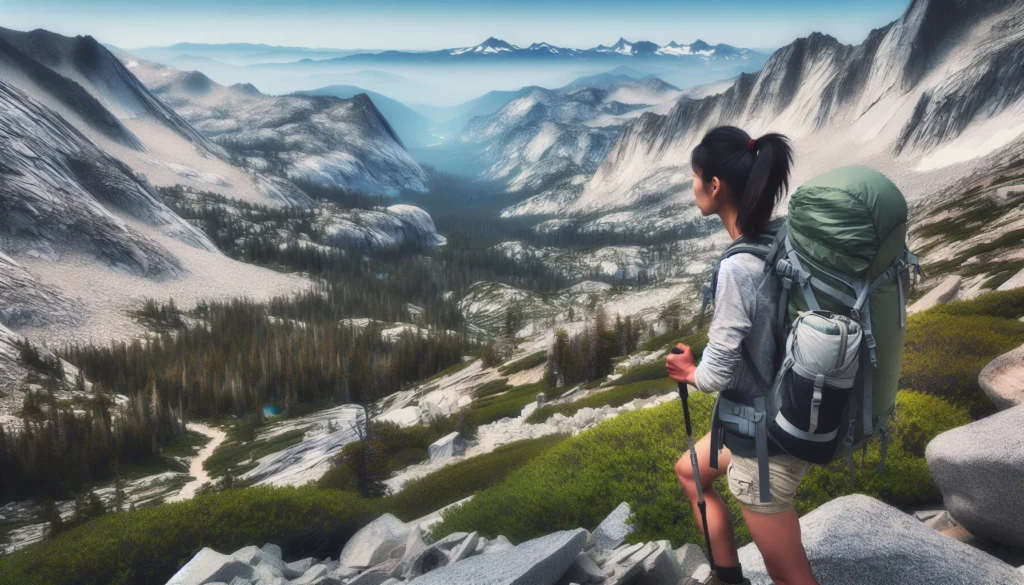Key Takeaways
- Thru-hiking is a long-distance, end-to-end hike completed on established trails, often spanning hundreds or thousands of miles in one season.
- Iconic trails like the Appalachian Trail, Pacific Crest Trail, and Camino de Santiago attract hikers with unique challenges, landscapes, and cultural experiences.
- Key aspects of thru-hiking include endurance, minimalist living, and adaptability, as hikers face diverse terrains, weather conditions, and resource management.
- Thru-hiking offers physical, mental, and emotional benefits, such as improved fitness, mental clarity, and resilience, while fostering a stronger connection with nature.
- Challenges include physical strain, changing weather, and mental fatigue, requiring preparation, problem-solving, and strong motivation to complete the journey.
- Practical tips for aspiring thru-hikers include thorough planning, investing in lightweight, essential gear, and breaking the journey into manageable goals to stay motivated.
I’ve always been fascinated by the idea of packing up my essentials, lacing up my boots, and setting off on a journey that stretches for hundreds or even thousands of miles. That’s the essence of thru-hiking—a long-distance hike that takes you across entire trails, often lasting weeks or months. It’s not just about walking; it’s about immersing yourself in nature, embracing challenges, and discovering what you’re truly capable of.
Thru-hiking isn’t your average weekend adventure. It’s a test of endurance, both physical and mental, as you navigate rugged terrains, unpredictable weather, and the solitude of the trail. But for those who take it on, it’s also a life-changing experience filled with breathtaking views, unforgettable moments, and a deeper connection to the world around them. Whether you’re dreaming of the Appalachian Trail or just curious about this lifestyle, thru-hiking is a journey like no other.
What Is Thru Hiking?
Thru hiking refers to the continuous, end-to-end hiking of an established long-distance trail, typically completed in a single attempt within one hiking season. These trails often extend hundreds or even thousands of miles, requiring sustained effort and dedication.
I often associate thru hiking with iconic trails like the Appalachian Trail (2,190 miles), the Pacific Crest Trail (2,650 miles), or the Continental Divide Trail (3,100 miles). Completing one demands physical strength, mental resilience, and meticulous planning. A thru hiker carries essential gear, food supplies, and navigational tools, balancing lightweight packing with meeting basic needs.
Thru hiking also involves embracing different trail environments. Whether it’s dense forests, high-altitude mountains, or unpredictable river crossings, each terrain tests adaptability and endurance. For example, the Appalachian Trail features steep climbs and humid climates, while the Pacific Crest Trail spans arid deserts and snowy passes.
Trail regulations, seasonal weather, and resupply logistics define the experience. I focus on managing these factors to ensure safety and sustainability during long journeys.
Key Characteristics Of Thru Hiking

Thru-hiking combines endurance, adaptability, and simplicity, defining what it means to complete a continuous long-distance trail. Several critical aspects emerge when considering this unique adventure.
Long-Distance Treks
Thru-hiking usually spans trails stretching hundreds or even thousands of miles like the Pacific Crest Trail (2,650 miles) or the Appalachian Trail (2,190 miles). These treks require one uninterrupted attempt during the same hiking season. Elevation changes, diverse ecosystems, and rugged terrains demand stamina and strong navigation skills.
Time Commitment
Completing a thru-hike requires a significant portion of the year, usually between 4 and 7 months, depending on the trail’s length. Weather windows often dictate start and end dates. For instance, hikers on the Continental Divide Trail (3,100 miles) commonly begin in late spring to avoid snow and finish by early fall.
Minimalist Lifestyle
Carrying limited gear is essential to thru-hiking, focusing only on necessities like lightweight tents, sleeping bags, and dehydrated food. Balancing comfort with pack weight is critical. Minimalism extends to daily living, where conserving resources like water and managing backcountry hygiene become priorities.
Popular Thru Hiking Trails Around The World

Thru-hiking offers incredible opportunities to explore some of the most celebrated trails across the globe. Each trail has its own unique challenges, landscapes, and cultural experiences.
Appalachian Trail (USA)
The Appalachian Trail stretches 2,190 miles along the eastern United States, spanning from Georgia to Maine. It crosses 14 states, passing through forests, mountains, and valleys with diverse ecosystems. This trail attracts both seasoned hikers and first-timers due to its accessibility and well-maintained shelters. Resupply points are frequent, making it easier to manage essential supplies during the journey.
Pacific Crest Trail (USA)
The Pacific Crest Trail runs 2,650 miles from Mexico to Canada, traversing through California, Oregon, and Washington. Its terrain includes deserts, volcanic landscapes, and alpine regions, offering a wide range of natural beauty. This trail requires advanced preparation due to remote sections and limited water sources in certain areas. Permits are crucial for entry and managing capacity along the trail.
Camino De Santiago (Spain)
The Camino De Santiago, or the Way of St. James, is a historic route that covers multiple paths across Europe, with the most famous being the 500-mile trek from St. Jean-Pied-de-Port in France to Santiago de Compostela in Spain. Unlike wilderness trails, this route passes through towns and villages, providing cultural immersion and access to accommodations. It’s a spiritual journey for many, blending hiking with centuries of tradition and history.
Benefits Of Thru Hiking

Thru-hiking offers transformative physical, mental, and emotional benefits that make the journey deeply rewarding. From improved fitness to a stronger mindset, the experience impacts multiple aspects of life.
Physical Fitness
Thru-hiking enhances overall physical health through prolonged, continuous activity. Hiking long distances daily strengthens muscles, improves cardiovascular endurance, and promotes joint mobility. Carrying a loaded backpack improves core stability and balance. For example, traversing trails with steep climbs, like the Pacific Crest Trail, builds significant lower body strength.
Mental Clarity
Thru-hiking creates mental clarity by disconnecting from technology and everyday distractions. Immersing myself in nature reduces stress, boosts focus, and enhances mindfulness. The rhythmic nature of walking fosters meditative states, allowing me to process thoughts and emotions more effectively. For example, spending days on remote sections of the Continental Divide Trail provides ample time for self-reflection.
Building Resilience
Facing constant challenges on long trails builds mental and emotional resilience. Unpredictable weather, difficult terrain, and physical fatigue teach adaptability and problem-solving. Pushing through tough moments on trails like the Appalachian Trail strengthens perseverance and self-confidence, making it easier to handle difficulties in daily life.
Challenges Of Thru Hiking
Thru hiking isn’t just a test of endurance; it’s a blend of physical trials, mental strain, and unpredictable environments. Each challenge shapes the journey, pushing hikers to their limits.
Physical Demands
Thru hiking requires sustained physical output over extended periods. Long daily mileage, often between 15 and 25 miles, stresses muscles and joints. Carrying a loaded backpack, even with lightweight gear, adds strain, particularly on the back, knees, and shoulders. Elevation changes, from steep ascents to rugged descents, demand a high level of cardiovascular fitness and leg strength. Injuries like blisters, sprains, and overuse issues are common and need attention to avoid derailing progress.
Weather And Terrain
Weather extremes can turn trails into constant challenges. Hot days deplete hydration and energy levels, while rain or snow turns paths into slippery hazards. Cold nights require adequate gear for warmth, increasing pack weight. Navigating diverse terrain, including rocky trails, river crossings, and snowfields, demands technical skills and balance. In higher altitudes, thin air and storms introduce additional risks. The unpredictability of conditions often requires flexibility and quick decision-making.
Mental Fatigue
Continuous exposure to physical exertion and isolation leads to mental strain. The monotony of daily routines like setting up campsites or pacing through long stretches without scenery can feel draining. Motivation wanes during difficult weather or after stringing together tough days. Dealing with loneliness, especially on remote trails, adds emotional burden. Overcoming these mental hurdles often involves building a strong mindset, focusing on incremental goals, or finding solace in the trail’s beauty.
Tips For Aspiring Thru Hikers
Thru-hiking demands preparation, resilience, and adaptability. I’ve compiled practical tips to help anyone rise to the challenges of long-distance hiking.
Planning And Research
Thorough planning lays the foundation for success on the trail. I always start by researching my intended trail’s length, difficulty, resupply locations, and seasonal weather patterns. Understanding trail regulations, such as permits or camping restrictions, ensures compliance. Studying trail maps and route guides helps me identify water sources, potential hazards, and notable landmarks. For better preparation, I join forums or communities where experienced hikers share insights and updates.
Gear Essentials
Carrying lightweight yet functional gear makes every mile more manageable. I pack a sturdy, weatherproof backpack and prioritize essentials like a high-quality sleeping bag, lightweight tent, and water filtration system. Breathable, moisture-wicking clothing and reliable hiking boots reduce discomfort. A small first-aid kit, navigation tools (like maps or GPS), and a headlamp with spare batteries are non-negotiable basics. To balance efficiency with sustenance, I bring compact, calorie-dense food and plan resupply stops.
Staying Motivated
Maintaining motivation keeps me moving despite physical and mental fatigue. Breaking the journey into manageable sections helps me avoid feeling overwhelmed. Celebrating small milestones, such as reaching resupply points, boosts morale. I remind myself of my reasons for thru-hiking, whether they’re personal growth or connecting with nature. Whenever monotony sets in, I find it helpful to focus on engaging with the surroundings or connecting with fellow hikers.
Conclusion
Thru-hiking is so much more than just walking long distances; it’s a journey that challenges and transforms you in ways you never imagined. It’s about embracing simplicity, finding strength in the face of adversity, and discovering a deeper connection with the world around you.
Whether you’re drawn to the physical challenge, the mental clarity, or the sheer beauty of nature, thru-hiking offers an experience like no other. It’s a chance to step outside the ordinary and immerse yourself in something truly extraordinary.
If you’ve ever thought about taking on a thru-hike, I say go for it. The trails are waiting, and so is the adventure of a lifetime.
Frequently Asked Questions
What is thru-hiking?
Thru-hiking refers to hiking an entire long-distance trail end-to-end in one continuous journey, typically completed within a single season. This rigorous outdoor activity often spans hundreds or thousands of miles, requiring physical and mental endurance as well as careful planning.
What are some popular thru-hiking trails?
Famous thru-hiking trails include the Appalachian Trail (2,190 miles, US), Pacific Crest Trail (2,650 miles, US), and Continental Divide Trail (3,100 miles, US). Other notable routes include the Camino De Santiago in Spain, which combines cultural exploration with spiritual discovery.
How long does a thru-hike take?
A thru-hike usually takes 4 to 7 months, depending on the trail length, weather conditions, and the hiker’s pace. The timeline may vary based on factors such as fitness level, trail difficulty, and seasonal access.
What gear is essential for thru-hiking?
Thru-hikers should carry a lightweight yet durable backpack, sleeping bag, tent, navigation tools, and adequate food supplies. Proper footwear, water filtration systems, and weather-appropriate clothing are also vital to ensure safety and comfort.
How can I prepare for a thru-hike?
Preparation involves physical training, researching the trail, planning resupply points, and ensuring you have the right gear. It’s also important to build mental resilience and flexibility to adapt to unexpected challenges on the trail.
What are the benefits of thru-hiking?
Thru-hiking improves physical endurance, strengthens muscles, and promotes cardiovascular health. It also fosters mental clarity, reduces stress, and builds adaptability by overcoming challenges. Many hikers find it a transformative, life-enriching experience.
What challenges can I expect during a thru-hike?
Challenges include physical exertion, weather extremes, injuries, isolation, and managing limited resources like food and water. Navigating difficult terrain and maintaining motivation can also test both physical and mental stamina.
Is thru-hiking suitable for beginners?
Though challenging, beginners can undertake a thru-hike with proper preparation, realistic goals, and training. Starting with shorter, well-maintained trails like sections of the Appalachian Trail is a great way to gain experience.
How do I stay motivated during a thru-hike?
Break the hike into smaller milestones, celebrate progress, and stay focused on your goal. Engaging with nature, practicing mindfulness, and connecting with fellow hikers can help maintain motivation throughout the journey.
What is the most important tip for thru-hiking success?
The key to a successful thru-hike is thorough planning paired with adaptability. Prepare for the unexpected, pack efficiently, stay hydrated, and listen to your body to ensure a safe, enjoyable adventure.

